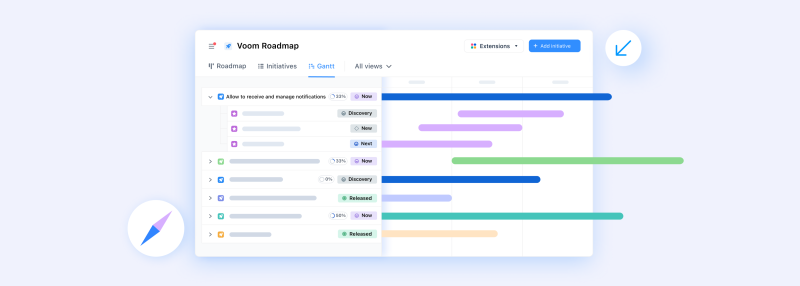The Best of Both Worlds: How to Pair a Gantt Chart with Your Roadmap

Hello, product people! Let's dive into a topic that's been causing a bit of a stir in our community. The age-old debate: Gantt charts versus roadmaps. It's like choosing between coffee and tea, or cats and dogs (lol jk, dogs all the way.)
But here's a wild idea: what if we didn't have to choose? What if we could have our cake and eat it too?
Before you jump down my throat, let me clarify one thing: I am not saying you should be using timelines or Gantt charts as roadmaps. Let’s all take a deep breath here.
What I am saying is that they’re two sides of the same coin, each with its own purpose and value. And just like a coin, you need both sides for it to be worth anything. For as long as I can remember, they’ve been treated like mortal enemies; two gladiators in a colosseum fighting to the death.
Maybe it’s time we really talked about what each of these mean and how you can best use them.

The roadmap: Setting direction
Let's start with the roadmap. First off, it’s important to highlight what a roadmap isn’t:
Not a task of things to do
Not a bunch of features you must build
Not a timeline
A roadmap outlines your product's goals and how you plan to achieve them. It helps communicate direction and intention, much like a flashlight in the dark. What is closest to you will be illuminated and clear, what is furthest away is still a bit fuzzy - but you know where you are going because of it.
A product roadmap focuses on communicating “what” and “why,” defining the problems you're trying to solve and the impact you want to make. Above all, it is there to make sure the entire company is aligned and supported (this is a key word here!) If your business-facing teams feel supported by the roadmap, they will be empowered to have better conversations with customers, giving them the ability to set the right expectations while being transparent about the company and product’s direction.

Can the roadmap communicate dates?
This is a question I get often. In short, yes, it can. Let’s be real, deadlines are things that happen, we can’t avoid them. Whether they’re due to events or regulatory industry deadlines, we must sometimes adhere to them.
There is, however, a big difference between a deadline, a timeline, and “timing.”
Deadline: The end date of a project (when the project is due.)
Timeline: The start and end date of a project (the project’s lifecycle)
Timing: Why you are choosing to focus on something at a given time.
A roadmap must always communicate timing (why this, why now), and will sometimes also communicate a deadline. But just because some projects have deadlines, it doesn’t mean all projects have deadlines. All projects have a level of scope and feasibility, and those often become stricter when a deadline is attached.
The purpose of a product roadmap is to be able to communicate what you’re working on, why you’re working on it, and why you’re working on it now. It may also communicate deadlines on specific projects, but its general intention is to provide a view of the direction of the problems you’re aiming to solve.
The Gantt chart: Your tactical playbook
Now, let's talk about the Gantt chart. Gantts are a visual tool that helps you manage your project timeline, resources, and dependencies. It's your tactical playbook, showing you the "when" and "how" of your product development process.
Gantt charts are all about execution. They help you track progress, identify bottlenecks, and keep everyone on the same page. They're not about setting strategic goals or defining outcomes; they're about getting things done.
In the past, Gantt charts and timelines have been confused for roadmaps. This is to be expected, after all it gives everyone a clear picture of what to expect. Gantt charts give certainty. They provide a list of things to do, and how and when to execute on them. But did anyone ever stop to wonder how those decisions were made in the first place?
There is always (or should always be!) some form of strategic meeting where everyone gets together to make the decision to work on something. Some form of guidance or direction that tells the team what they will execute on next. You guessed it, that’s what the roadmap is for!
Using your roadmap and Gantt chart together
As a product manager, you wear many hats: you're a strategist, setting the direction and defining the vision for your product. You're also an executor, managing the nitty-gritty details of product development and ensuring everything runs smoothly.
Your roadmap and Gantt chart are tools that help you fulfil these roles. The roadmap helps you with the strategic part of your job, while the Gantt chart assists with the execution. They're like two peas in a pod, each complementing and enhancing the other.
So, when should you use a roadmap, and when should you use a Gantt chart? Well, it's not a matter of either/or. It's more about using the right tool for the right job.
Use your roadmap when you're setting the strategic direction for your product. It's perfect for communicating your product's goals and vision to stakeholders, aligning your team around a common purpose, and making sure everyone understands the "why" behind what you're doing.
On the other hand, use your Gantt chart when you're planning and managing the execution of your product development process. It's ideal for tracking progress, managing resources, and ensuring everything is on track.
Think of it this way: your roadmap is the script for your product's story, and your Gantt chart is the storyboard. The roadmap sets the direction and the plot, while the Gantt chart breaks down the scenes and sequences. They tell two different sides of the same story, and you need both to create a compelling narrative.

Do I have to use a Gantt chart?
Well, no. You don’t have to. There are other ways of communicating specifics, including timelines, calendars, or even just meetings with bullet points. The idea here is not to force anyone to use timelines or Gantt charts in any way, it is to highlight the importance of communicating both strategy and execution.
You want to give leadership as much certainty as possible without overpromising or under delivering. Certainty is a tricky word, of course, because we only know what we know at any given point in time. But if you’re able to communicate things with evidence, confidence, and on an ongoing basis, you’ll be able to build trust.

Conclusion
So there you have it, product friends. The ongoing debate of timelines vs roadmaps is a false dichotomy. It's not about choosing one over the other; it's about understanding how these two tools can complement each other.
As a product manager, your job is both strategic and tactical. You need to set the direction and make things happen. And to do that effectively, you need both a roadmap and a Gantt chart.
So, let's stop pitting these two tools against each other. Instead, let's embrace their duality and use them to their full potential. After all, two heads are better than one, right?

Andrea Saez

Read also



Build great roadmaps

Experience the new way of doing product management



